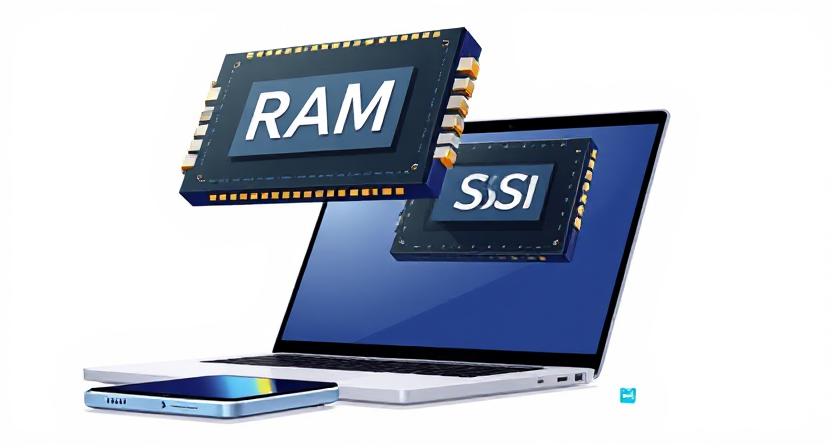🧠 RAM vs. Storage: What Matters More in a New Device (2025 Guide)
When shopping for a new laptop, smartphone, or tablet in 2025, you’ll see two specs everywhere: RAM and Storage. These are among the most important hardware features, yet they often confuse buyers. Understanding the difference between RAM vs. Storage—and what matters more in a new device— can help you make a smarter decision and avoid overspending.
Let’s explore how these components work, what role they play in your device’s performance, and how to choose the right balance.

🔍 Understanding RAM vs. Storage: What’s the Difference?
Before deciding which matters more, let’s break down what each component does:
- RAM (Random Access Memory) is your device’s short-term memory. It temporarily stores data your device is actively using. More RAM means faster performance, better multitasking, and a smoother user experience.
- Storage is your long-term memory. It holds your files, photos, videos, apps, and the operating system itself. It’s usually measured in gigabytes (GB) or terabytes (TB).
Key takeaway: RAM affects how fast your device runs, while storage affects how much data your device can hold.
🧪 RAM vs. Storage: What Matters More for Daily Use?
Choosing between RAM vs. Storage depends on how you use your device. Here’s a breakdown of the most common scenarios:
1. For Browsing and Office Work
- Use Case: You browse the web, use email, edit documents, and maybe attend video meetings.
- What Matters More: RAM
You’ll want at least 8 GB of RAM to keep multiple tabs open and run productivity apps without lag. Storage can be minimal (256 GB SSD) if most of your files live in the cloud.
2. For Students and Remote Workers
- Use Case: School work, online classes, document editing, light media consumption.
- What Matters More: Balanced
Get a device with 8 GB RAM and at least 256 GB SSD storage. RAM helps with video conferencing and multitasking, while storage supports offline file access.
3. For Gamers and Creatives
- Use Case: Gaming, video editing, 3D modeling, or music production.
- What Matters More: Both Are Critical
You’ll need 16–32 GB RAM to handle heavy applications and a 1 TB SSD to store large game or media files. An NVMe SSD will boost loading times dramatically.
4. For Budget-Conscious Buyers
- Use Case: Basic use with limited apps and media.
- What Matters More: Storage (but fast type like SSD)
Even a device with 4 GB RAM can perform well if it uses SSD storage, which is significantly faster than an old HDD. Opt for 128–256 GB SSD to stay efficient.
📊 How Much RAM Do You Need in 2025?
| User Type | RAM Recommendation |
|---|---|
| Light User | 4–8 GB |
| Everyday Multitasker | 8 GB |
| Gamers/Designers | 16–32 GB |
| Developers | 32 GB+ |
Note: In most laptops and smartphones, RAM isn’t upgradeable. Choose wisely upfront.
💾 How Much Storage Do You Need in 2025?
| User Type | Storage Needed |
|---|---|
| Cloud-First Users | 128–256 GB SSD |
| General Productivity | 256–512 GB SSD |
| Gamers/Creators | 1 TB+ SSD |
You can always expand storage later using cloud services like Google One or external drives, but internal RAM cannot be added to most mobile devices or ultra-thin laptops.
🔁 RAM vs. Storage: Which One Can You Upgrade?
RAM:
- Upgradeable? Sometimes.
- Many modern laptops solder RAM to the motherboard, especially thin and light models.
- Desktops and some gaming laptops allow RAM upgrades.
Storage:
- Upgradeable? Frequently.
- SSDs in many laptops can be replaced or expanded.
- External SSDs offer fast plug-and-play storage options.
🔄 Real-World Analogy: RAM vs. Storage
Imagine your device as an office:
- RAM is your desk space—the more room you have, the more work you can do at once.
- Storage is your filing cabinet—it holds your papers (files), but accessing them takes more time than using what’s on your desk.
If your desk (RAM) is too small, you constantly shuffle papers in and out, slowing everything down. But if your cabinet (Storage) is too small, you run out of space to keep things.
🧠 Final Verdict: RAM vs. Storage — What Matters More?
There’s no one-size-fits-all answer. The better question is: what matters more for you?
- Need faster performance? Prioritize RAM.
- Need to store lots of files or apps? Focus on Storage.
- Want long-term value? Invest in both.
The sweet spot for most users in 2025 is:
- 8–16 GB of RAM
- 256–512 GB of SSD Storage
✅ Quick Recommendations (2025):
| Scenario | Minimum RAM | Minimum Storage |
|---|---|---|
| Student | 8 GB | 256 GB SSD |
| Business User | 8 GB | 512 GB SSD |
| Gamer | 16 GB | 1 TB SSD |
| Budget Shopper | 4–8 GB | 128–256 GB SSD |
Published by:
Tech Hello Latch — Your trusted guide to smarter tech decisions in 2025.

